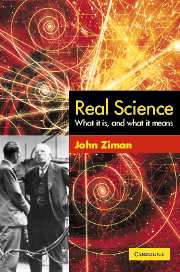Book contents
- Frontmatter
- Contents
- Preface
- 1 A peculiar institution
- 2 Basically, it's purely academic
- 3 Academic science
- 4 New modes of knowledge production
- 5 Community and communication
- 6 Universalism and unification
- 7 Disinterestedness and objectivity
- 8 Originality and novelty
- 9 Scepticism and the growth of knowledge
- 10 What, then, can we believe?
- Endnotes
- Bibliography and author index
- Index
10 - What, then, can we believe?
Published online by Cambridge University Press: 24 August 2009
- Frontmatter
- Contents
- Preface
- 1 A peculiar institution
- 2 Basically, it's purely academic
- 3 Academic science
- 4 New modes of knowledge production
- 5 Community and communication
- 6 Universalism and unification
- 7 Disinterestedness and objectivity
- 8 Originality and novelty
- 9 Scepticism and the growth of knowledge
- 10 What, then, can we believe?
- Endnotes
- Bibliography and author index
- Index
Summary
Understanding and explanation
Science produces knowledge. This is something more than codified information. As we have seen, the notion of ‘knowledge without a knower’ [9.3] cannot be taken literally. The myriads of facts and theories in the scientific archives have been shaped by the requirements of interpersonal communication. They have to be meaningful: they have to be capable of being understood.
This meaning may only apply in a very esoteric context. The necessary understanding may be limited to a tiny, highly specialized research community. The production process may have involved an opaque conglomeration of automatic instrumentation, computation and symbolic manipulation. Nevertheless, the norms and practices of academic science require that the nature of this process and its final products should have been communicated to and consciously accepted by human minds. As I have repeatedly stressed, the epistemology of science is inseparable from our natural faculty of cognition.
But scientific communications must not only be comprehensible: they also, typically, enable comprehension. For reasons that we have discussed at length, they relate directly or indirectly to shared aspects of the life experiences of those who utter and receive them. In a word, they are messages that we send to each other about the ‘world’ that we seem to have in common. They thus help us to understand that world.
‘Understanding’ is a complex process, of which we know less about the parts than about the whole.
- Type
- Chapter
- Information
- Real ScienceWhat it Is and What it Means, pp. 289 - 330Publisher: Cambridge University PressPrint publication year: 2000



